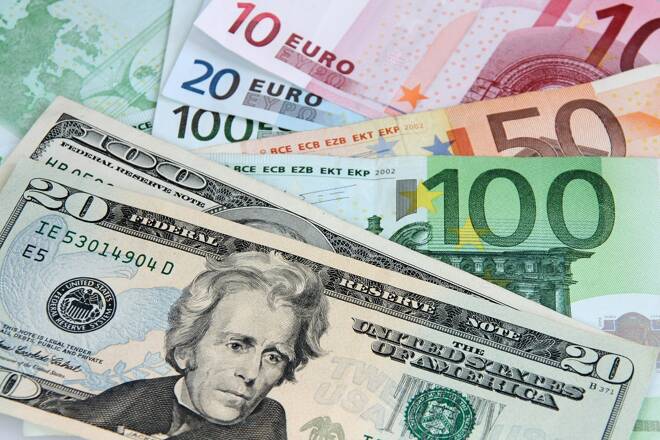Advertisement
Advertisement
EUR/USD Forecast: Euro Area and US Prelim Private Sector PMIs to Take Center Stage
By:
In the EUR/USD analysis, the Eurozone services sector's performance, alongside US Services PMI, holds the key to short-term forecasts amid global events.
Highlights
- The EUR/USD rallied 0.71% on Monday, ending the session at $1.06685.
- A sharp decline in US Treasury yields weighed on the appetite for the US dollar.
- On Tuesday, euro area and US prelim private sector PMIs will be in the spotlight.
Friday Overview
On Monday, the EUR/USD rallied 0.71%. Following a 0.10% gain on Friday, the EUR/USD ended the day at $1.06685. The EUR/USD fell to a low of $1.05714 before rising to a high of $1.06779.
Euro Area Private Sector in the Spotlight
German GfK consumer confidence numbers need consideration on Tuesday. A pickup in consumer confidence would signal an improving private consumption environment. However, the numbers will likely play second fiddle to euro area private sector PMIs for October.
Private sector PMIs for France, Germany, and the Eurozone need consideration.
The services sector contributes over 70% to the Eurozone economy. A return to service sector growth may fuel bets on an ECB rate hike to tame inflation. Significantly, the services sector (+2.05 percentage points) was the most marked contributor to Eurozone inflation in September. Higher interest rates would impact borrowing costs and demand for services, easing services sector-related inflation.
Economists forecast the HCOB Eurozone Services PMI to remain unchanged at 48.7.
US Services PMI to Influence Fed Rate Hike Bets
On Tuesday, the US S&P Global Services PMI will influence market bets on a Fed interest rate hike. Hotter-than-expected numbers may force the Fed to raise interest rates to curb demand and demand-driven inflationary pressures.
The US services sector contributes over 75% of US jobs. A pickup in sector activity would increase the need for workers, pushing wages higher. Higher wages would fuel consumption and demand-driven inflationary pressures.
Economists forecast the Services PMI to fall from 50.1 to 49.8. A contraction across the services sector would likely ease pressure on the Fed to deliver a December Fed rate hike.
Beyond the economic calendar, investors should monitor news updates from the Middle East. An escalation in the conflict, drawing Iran into the picture, may fuel demand for the US dollar.
Short-Term Forecast:
While the Middle East conflict remains a focal point, euro area and US services PMIs will influence short-term trends. Better-than-expected numbers from the euro area and a contraction in the US services sector would drive buyer demand for the EUR.
EUR/USD Price Action
Daily Chart
The EUR/USD sat above the 50-day EMA while remaining below the 200-day, sending bullish near-term but bearish longer-term price signals.
A EUR/USD return to $1.07 would support a move to the 200-day EMA and the $1.07838 resistance level.
Better-than-expected private sector PMIs will likely drive the buyer appetite for the EUR. However, the market may need a de-escalation in the Middle East conflict to make a decisive move.
An escalation in the Middle East conflict and a slump in euro area service sector PMIs would test buyer demand.
A EUR/USD drop below the 50-day EMA would bring the $1.06342 support level into play.
The 14-period Daily RSI, 57.46, suggests a EUR/USD move to the 200-day EMA before entering overbought territory.
4-Hour Chart
The EUR/USD holds above the 50-day and 200-day EMAs, sending bullish price signals.
A EUR/USD return to $1.07 would support a move toward the $1.07838 resistance level.
However, a break below the $1.06342 support level and the 200-day EMA would give the bears a run at the 50-day EMA.
The 14-period RSI on the 4-hour chart, 75.45, shows the EUR/USD in overbought territory.
About the Author
Bob Masonauthor
With over 28 years of experience in the financial industry, Bob has worked with various global rating agencies and multinational banks. Currently he is covering currencies, commodities, alternative asset classes and global equities, focusing mostly on European and Asian markets.
Advertisement
